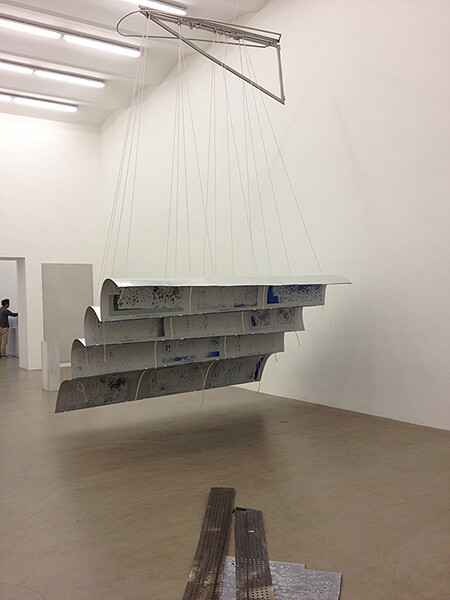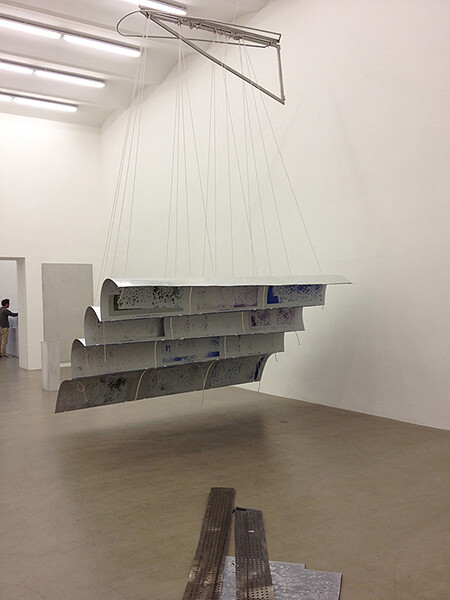September 20–October 25, 2012
Everything feels hyper-politicized right now. This is true in the real world, of course … and, increasingly, in the art world. Lately, at least in Central Europe, fake (or “fake”?) Occupy camps are cropping up at nearly every major contemporary art event. The recent Berlin Biennale’s camp-as-university is probably the most notorious example, but there was also the ragtag tent encampment in front of the Fridericianum at Documenta 13. Even at last week’s ViennaFair (September 20–23, 2012), a rotating group of artist-activists blogged, DJed, and performed in an enclosed area at the edge of the exhibition hall, irritating gallerists with booths nearby with their raucousness.
Sigh. Considering this often contrived, too-obvious appropriation of “politics” makes this year’s “curated by” in Vienna all the more refreshing. “Kunst or Leben: Ästhetik und Biopolitik (Art or Life: Aesthetics and Biopolitics)” is the overriding theme of a citywide event generously funded by the city of Vienna’s creative agency, Departure, since 2009. (Amazing but true: some cities have agencies to financially support creative endeavors and industries—residents of those without can keep dreaming). We can thank curator Eva Maria Stadler for adding the “bio” to the “politics”: this edition of “curated by” is meant to re-address—through the eyes and minds of international curators invited to mount shows in Vienna’s 22 hosting galleries—the old avant-garde idea that art and life should be united. At the same time, it confronts the definition of biopolitics —primarily attributed to Foucault—that asserts that technologies, economies, and governments exert power over our very bodies, over life itself (for better or worse). But instead of reenacting protest or plopping the common imagery of current events in front of us, Stadler (and this is the “aesthetics” part) asks her curators to work through their interpretations of biopolitics with, gulp, actual artwork.
Without a tent in sight, there are plenty of good artworks and interesting curatorial efforts to see all around, but three exhibitions are especially sticky, addressing the Art or Life issue in markedly different ways. At Galerie Meyer Kainer, in a show curated by Will Benedict, German artist Nora Schulz presents a group of sculptures that seem as provisional as they are initially puzzling. Any familiarity with Schulz’s work indicates that these rough bits of perforated metal—interlaced with materials like tubing and plastic—are parts of a performative process that the artist has finished and left for the viewer to decipher or even complete. Her centerpiece, however, is an oversize sculpture made of connected curved metal sheets suspended from the ceiling. Here, too, the material is left unfinished: one can only imagine the artist finding, appropriating, and manipulating objects in a process that is as physical as it is conceptual. Reminiscent of a makeshift sail or, maybe, an especially clever element of a favela roof, it’s a piece that plays with balance, ephemerality, and incompleteness. The group of concrete minimalist pieces by Austrian artist Anita Leisz, also on view here, provides a welcome counterbalance with their crisp forms, solidity, and sense of completion.
Over on the Schleifmühlgasse gallery strip, Galerie Georg Kargl is the indisputable standout, with curator Thomas Locher’s excellent group show “On Signs and Bodies.” Locher presents us with a whole lot of reminders of how representation can render the individual as a mere abstraction. Several older works by American artist Peter Fend address admittedly odd utopian/dystopian theories expressed in abstract charts (like Untitled/Carbon + Water, 1998,) or a manipulated world map (World to Be, 1998). Andreas Siekmann’s Trickle Down, Der öffentliche Raum im Zeitalter seiner Privatisierung (Trickle Down, the Public Space in the Age of Its Privatization, 2007) is an unsettling series of posters with text and symbols tracing how cities are rebranded and gentrified. Several elaborate works by Italian artist Gianfranco Baruchello (from 2009) combine tiny symbols, anatomical diagrams, cut paper, and drawings to create a universe of symbolic thought. And Yael Bartana’s powerful animated video ENTARTETE KUNST LEBT (Degenerate Art Lives, 2010) depicts an expanding group of marching war cripples hobbling on wooden legs or creaky wheelchairs; striking figures that originated in an Otto Dix painting that the Nazi regime had confiscated and burned as degenerate art. Overall, “On Signs and Bodies” is one of those rare gallery exhibitions a viewer could spend hours in, and be haunted by for days, or weeks, afterward.
Back on Eschenbachgasse (a couple of doors down from Meyer Kainer) is another gem of a group show at Galerie Martin Janda, which takes a more personal, physical approach to the biopolitical question. Curator Thomas D. Trummer contrasts two younger contemporary positions—Turin-born Lara Favaretto and British star Ryan Gander—with the late Polish artist Alina Szapocznikow (1926–1973), a survivor of three concentration camps and—in spite of a recent major traveling retrospective—still an underrated representative of Eastern European postwar art. The younger artists throw themselves uncomfortably into modern life: Favaretto presents a huge rectangular block of concrete marked with a deep indentation on each side—where she put her hands before the material hardened—in a dramatic physical gesture. In a film running in the gallery’s lower level, Gander’s protagonist walks toward the camera along a bridge in a sequence lasting just a few seconds; the film cuts off abruptly but repeats continually, with a slight difference each time (the man is sometimes wearing sunglasses, sometimes a hoodie, etc.). It seems to be a rather trite comment on how life is made up of banal patterns and gestures that may or may not be significant.
But the show’s gravitas unfolds slowly, and largely comes from the wildly surreal work of Szapocznikow. The artist works with and manipulates her own body, rendering her own belly in polyurethane, for example; her drawings and sculptures in bronze literally stretch, clump, and abstract the physical form into works that are profoundly existential. Despite their small size and almost delicate appearance, Szapocznikow’s pieces possess an authenticity that feels infinitely more political than any encampment at an art mega-event could ever be. They are a reminder of the fact that it’s not really a question of art or life, but rather one of how the myriad aspects of art and life can be “occupied” and understood.








